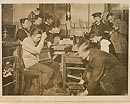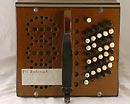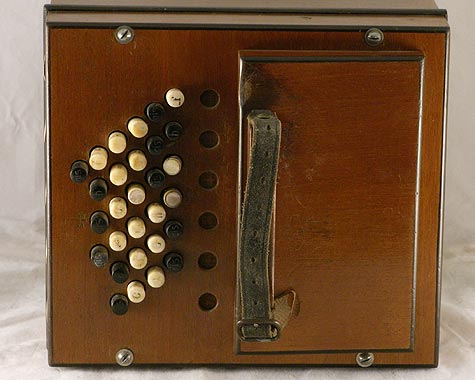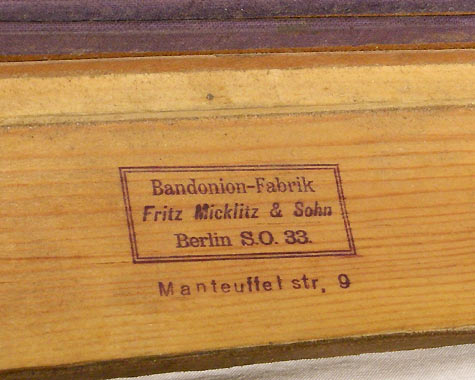
Zademack-Bandonion
System: Zademack, 118 tones
unisonoric, logical
(Collection Oriwohl, Nr. 195)
Manufacture: Co. Fritz Micklitz (Altenburg, Thuringia) 1911
2-choirs (8'+4'), 1 bisonoric key: f/fis
The not patented model developed by Julius Zademack, was soon copied by other instrument makers.


Front side of a postcard:
View into the workshop of Fritz Micklitz (presumably with cap). In the centre you can see a tuning table at which a worker is pre-tuning the reedplates outside the instrument. The final tuning is carried out in the installed state.
This is a photo postcard that was very popular before the advent of the mobile phone to send personal pictures with greetings to acquaintances. The principle of personalised photo greetings was already popular back then. Only the dispatch time was slightly different from today.


Back side of a postcard:
"First chromatic bandoneon factory by F. Micklitz. Unrivalled precision fabrication. Altenburg (Thüringen). Zwickauerstr.33. Muttelchens Taillenweite 91cm [Mum's waist size 91cm], Hüftweite 116cm [Hip width 116cm].
Reichenberger str.111"
The presumed message to "Mum's" tailor's shop is the reason for this contemporary testimony to thank.


Right side:
Keyboard according to the system of Julius Zademack.
The top row is a duplication of the bottom row. Neighbouring vertical rows are in the ratio in fifths, comparable to the sides of a violin or zither. The frets of the latter correspond to the keys, which are arranged chromatically in the vertical.
The semitones are black in colour. In difference to the previous model, for better ergonomics the rows are now slightly curved.
The lone white key at the top operates the air flap.


Left side:
Keyboard according to the system of Julius Zademack
The black keys are semitones.


Left side of a later Zademack bandonion
The instrument was constantly developed and the left manual was expanded, but later replaced by another one.
The key interval between two Keys is a fifth vertically and a sixth or diatonic sequence obliquely.
The outer row with 6 keys is an auxiliary row (repeat row) with the first 6 tones of row 1 inside.


Left side
The instrument has also changed under the left case cover. The impressive triple shaft on the previous Zademack has been replaced by a clearly structured Reformklaviatur, with tightly spaced key levers and a crossbar for rows 1 to 3.
The Reformklaviatur was patented in 1921 by the instrument maker Hugo Stark.


The right side now also has a Reformklaviatur for 3 of the 5 rows of keys.
The valves are no longer firmly connected to the key levers, but only have a short lever. This is pressed down by a screw on the underside of the key lever.
The valves are pressed onto the tone hole by means of a under suspension. This is a coil spring that sits under the short valve lever. The most common is an upper suspension, in which a spring arm presses on the valve from above.


Company stamp inside from the entry instrument:
"Bandonion- Fabrik, Fritz Micklitz & Sohn, Berlin S.O.33, Manteuffel str.9"
